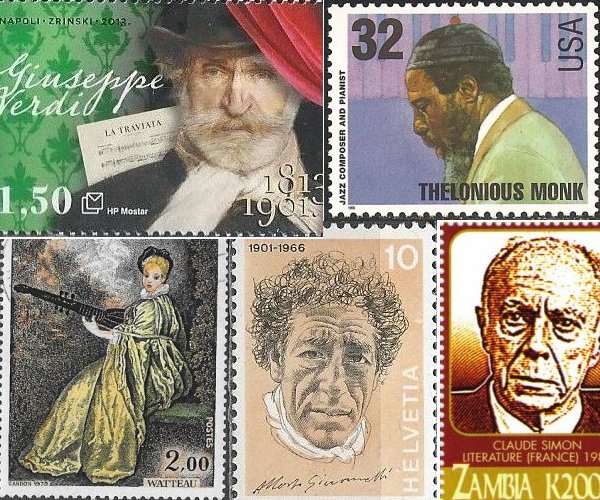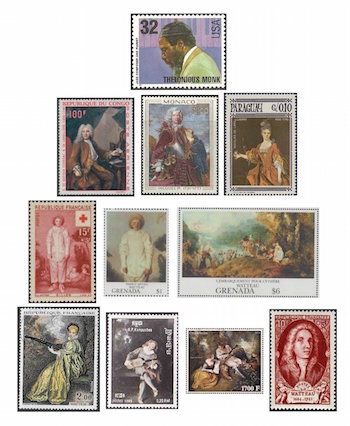The Arts on Stamps of the World —October 10
An Arts Fuse regular feature: the arts on stamps of the world.

By Doug Briscoe
Today is the centenary of Thelonious Monk. Giuseppe Verdi, Antoine Watteau, and Alberto Giacometti are our other leaders today. We have four additional painters, and there should be stamps for four writers, two of them Nobel Laureates, but again I must wag a finger at the UK, who have neglected to make a stamp for one of their great talents, Harold Pinter (10 October 1930 – 24 December 2008). There’s a Fado singer in the lineup, too.
The year 2013 saw a mazzone of stamps for the bicentenary of Giuseppe Verdi, born on this day in 1813. (Did you know he died on Mozart’s birthday, 27 January 1901?) I love the Bosnian one with the rich green damask wallpaper and crimson, gold-tasseled curtain. The oldest are at the top, with the earliest, the pair at left, dating from 1951.
I would have expected to see a few more worldwide stamps for the great American jazz pianist and composer Thelonious Monk, given that this year is his centennial year (born October 10, 1917 – died February 17, 1982), but we have, it appears, only the one US issue from 1995, part of a set honoring jazz masters. Did you know his middle name was Sphere? He was named for his maternal grandfather, Sphere Batts (so why not Baseball Batts?). Monk was born in North Carolina and was taken at age four to Manhattan. Within the next year or two he was learning piano, and by his teens was a professional. His first records, though, were not made until 1944, and his breakthrough album, Brilliant Corners, had to wait until 1956. Monk’s Dream (1963) did even better. Monk may have suffered from bipolar disorder, and he performed little in his last decade. He died of a stroke at 64.

Before we turn to Watteau, let’s first have a look at another French painter born nearly three decades earlier, Nicolas de Largillière (October 10, 1656 – March 20, 1746). Born in Paris, he went as a very small child to Antwerp and then London, opting at age 18 for England, where he was a student and friend of Peter Lely. Both Charles II and James II desired Largillière to remain in England, but as a Catholic he was made apprehensive by the Rye House Plot of 1683 and returned to Paris. Largillière’s forte was portraiture, and he left images of royalty and the nobility. The Congolese stamp offers his portrait of the lawyer Gaspard de Gueidan (1688-1767); Prince Jacques I of Monaco comes next; and on the Paraguayan stamp is Portrait of a Woman, possibly Madame Claude Lambert de Thorigny.
Largillière lived to be 89, but Jean-Antoine Watteau, who was baptized on this day in 1684, was only 36 when he died on July 18, 1721. He was born in Valenciennes and had delicate health from childhood. He found a place in the workshop of Claude Gillot, who enjoyed painting characters from the Italian commedia dell’arte and passed on his predilection to his pupil. One of the results, years later, was one of Watteau’s most famous pictures, a Pierrot known as “Gilles” (1718-19). It appears on stamps of France and Grenada. Watteau made such an impression with his attempt for the Prix de Rome in 1712 that he was immediately accepted as a full member of the Royal Academy (and did not undertake the usual government-sponsored trip to Italy). The work he produced as his entrée to the Academy was another of his most prized paintings, the Embarkation for Cythera (1720), seen on another Grenadan stamp. In the next row we have three musical pictures: La finette (c1717, stamp of France), A Mezzetino (1717-19, Cambodia), and The Love Song (c1717, Côte d’Ivoire), along with another French stamp honoring the artist himself.
October 10 is also the birthday of Finnish writer Aleksis Kivi (1834 – 31 December 1872). He is credited with having written (says the Wikipedia article) “the first significant novel in the Finnish language, Seven Brothers.” Born Alexis Stenvall into a tailor’s family, he also wrote a dozen plays and a poetry collection. “In 1865 Kivi won the State Prize for his still often performed comedy The Cobblers on the Heath,” to which Uuno Klami wrote an overture in 1936. Kivi suffered from alcoholism and schizophrenia and died in poverty at the age of 38. There are settings of Kivi’s poems by Sibelius, Leevi Madetoja, and Kimmo Hakola. Indeed, all three composers set the text shown on the more recent (1984) Kivi stamp: his “Sydämeni laulu” (“Song of my heart”). The late Einojuhani Rautavaara wrote an opera about Kivi’s life in 1995-96, and at around the same time an orchestral work, “Isle of Bliss”, inspired by Kivi’s poem “Home of the Birds”. A movie, The Life of Aleksis Kivi, appeared in 2002.

The Romanian-Jewish realist painter Nicolae Vermont (October 10, 1866 – June 14, 1932) was contributing pictures to a Bucharest journal when he was 18. He completed his artistic education at Munich in 1893, joined an art group, and in 1896 and 1898 co-founded two more, both of which sought renewal in Romanian art. This he did in part by addressing social issues in his work, e.g. Two Workers on Strike. The stamp, though, shows a typical genre piece, The Conversation. Vermont converted to Orthodox Christianity late in life. Another lovely piece is Nămăeşti Monastery (c1901).
Another painter from Eastern Europe was the Bosnian expressionist Lazar Drljača (10 October 1882 – 13 July 1970). He studied in Vienna and Paris, exhibiting in Rome in between. Throughout the First World War he was interned on Sardinia. He held numerous solo exhibitions, mostly in Sarajevo and Mostar, in the 1930s, but none was held again until 1962, on the occasion of his eightieth birthday. On his permanent return to Bosnia around 1935 he had adopted a life of seclusion, eventually taking his abode in a mountain villa. Much of his work was lost in a fire in the 1940s, but Drljača did not regret this conflagration. On the Yugoslav stamp we see The Black Lake at Durmitor (1935). Much more of his work can be seen on the French language Wikipedia page.
Our last 20th-century artist for the day is the best known of them, Alberto Giacometti (10 October 1901 – 11 January 1966). His father Giovanni was a well known post-Impressionist painter. (Here’s one of his paintings, Capolago with a View to the Corvatsch of 1926.) Alberto studied art in Geneva and in Paris under the sculptor Antoine Bourdelle (whose birthday comes at the end of the month). He associated with Picasso, Miró, and Max Ernst. From 1936 he concentrated on sculpture, the area for which he is most remembered today, although he also worked as a painter, draftsman, and printmaker. His figures are characteristically stick thin, as in The Dog (Le chien, 1951), shown on the French stamp, and L’Homme qui marche I (1960), which appears on the reverse of the Swiss 100 franc banknote (with Giacometti’s face on the obverse). Giacometti’s brothers also became artists, Diego a sculptor, Bruno an architect.
In 1977 Kota Shivaram Karanth (10 October 1902 – 9 December 1997) was the thirteenth writer –and only the third representative of the Kannada language—to receive India’s highest literary honor, the Jnanpith Award. He was born in Karnataka in southwest India and was active not only as a novelist and playwright, but in social causes, environmentalism, painting, the ancient stage genre (with music and dance) of Yakshagana, and as a filmmaker. He wrote two books about Yakshagana in addition to his 47 novels, 31 plays, two poetry collections, 13 art books, etc., etc.
Portuguese Fado singer and guitarist Carlos Ramos (10 October 1907 – 9 November 1969) was born and died in Lisbon. He had originally hoped to be a doctor, but needed to support his family on the early death of his father and turned to radiotelegraphy, which he had learned in military service. He kept up his music, however, and in 1939 accompanied other Fado singers to a festival in New York. He turned professional in 1944 and became one of the most beloved performers of the genre. Ramos also appeared as a musician in several films. As a songwriter he composed a number of nostalgic hits.

Well, as stated above, we have no stamp for Nobel prize winner Harold Pinter, but we do have one for French Laureate Claude Simon (10 October 1913 – 6 July 2005), a novelist and critic. He was born in Tananarive, the capital of Madagascar, to an officer who fell in the First World War, after which Claude grew up in Perpignan. He spent some time at both Oxford and Cambridge and, back in France, took courses in painting. He started writing his first novel, Le Tricheur (The Cheat, published 1946), before World War II and completed it only after being captured at the Meuse in 1940, escaping, and joining the Resistance. Indeed war is a common thread throughout his work, which tends to the verbose à la Proust and Faulkner and is marked by the devices of time-shifting, stream of consciousness, and a paucity of punctuation. His receipt of the 1985 Nobel Literature Prize irritated the hell out of Christopher Hitchens, who had taken issue with Simon’s dismissal of Orwell’s Homage to Catalonia as “faked from the very first sentence”. Hitchens (whom I miss terribly) blew a bit of a gasket and condemned Simon’s output as “a shady literary enterprise.” But admirers find in Simon’s novel The Flanders Road (1960), the second volume of a loose tetralogy, his masterpiece.
A graduate of the University of Massachusetts with a B.A. in English, Doug Briscoe worked in Boston classical music radio, at WCRB, WGBH, and WBUR, for about 25 years, beginning in 1977. He has the curious distinction of having succeeded Robert J. Lurtsema twice, first as host of WGBH’s weekday morning classical music program in 1993, then as host of the weekend program when Robert J.’s health failed in 2000. Doug also wrote liner notes for several of the late Gunther Schuller’s GM Recordings releases as well as program notes for the Boston Classical Orchestra. For the past few years he’s been posting a Facebook “blog” of classical music on stamps of the world, which has now been expanded to encompass all the arts for The Arts Fuse.
